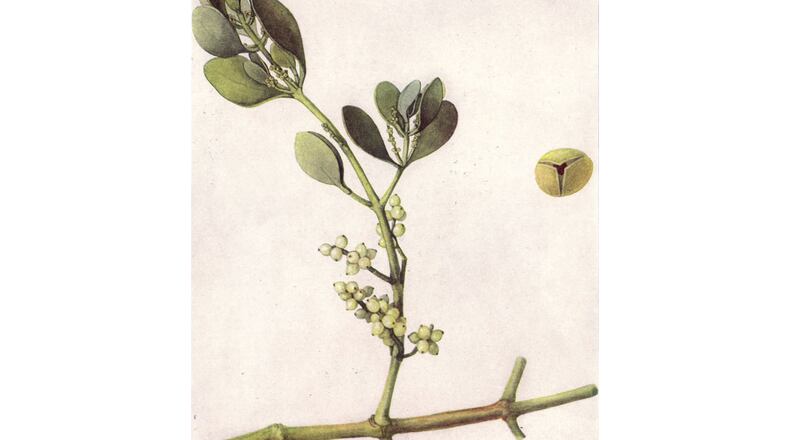When I was growing up on Johns Island, South Carolina, near Charleston, it was about this time of year when we would grab our shotgun and go hunting — for mistletoe.
Mistletoe, an evergreen, grows high on tree branches, so we used a shotgun to blast it from the treetops for easy retrieval. We’d cut it into sprigs that Mother would use to brighten our home with greenery for Christmas.
Decorating with mistletoe — a symbol of love, fertility and good luck — for the holidays is a time-honored tradition across America. It also might be good for romance: Many poems, songs and stories have been written about the celebrated custom of kissing under mistletoe.
Mistletoe, though, also is a semi-parasite. Chlorophyll in its leathery, oval-shaped leaves allows it to make food through photosynthesis, but its roots must suck water and nutrients from its host tree for growth. Once a sticky mistletoe seed lands on a suitable tree limb (often via a bird dropping), the seed sends out “roots” that penetrate the wood and tightly anchor the mistletoe to the limb — and rob it of water and nutrients. Heavy mistletoe growths could eventually kill a tree.
Georgia’s most common mistletoe species is the oak mistletoe (Phoradendron leucarpum). In addition to oaks, it also grows on scores of other tree species. It grows all year long but is mostly hidden during summer by a tree’s thick foliage. In autumn, when tree leaves have fallen, the bright green mistletoe growths stand out.
Oak mistletoe produces white berries — each containing one seed — from tiny yellow flowers. The berries are mildly toxic to humans but are favored by an array of wildlife, including bears, squirrels, chipmunks, bluebirds, robins, chickadees, mourning doves and others. It is also the host plant for the caterpillar of the great purple hairstreak butterfly.
Humans may benefit, too: Mistletoe extracts are being widely studied as possible treatments for colorectal cancer and some other maladies.
IN THE SKY: From David Dundee, Tellus Science Museum astronomer: The annual Geminid meteor shower will peak at about 50 meteors per hour on Monday night in the northeastern sky. The moon is in first quarter. Venus (high), Jupiter and Saturn are in the west at sunset.
Charles Seabrook can be reached at charles.seabrook@yahoo.com.
About the Author
Keep Reading
The Latest
Featured



